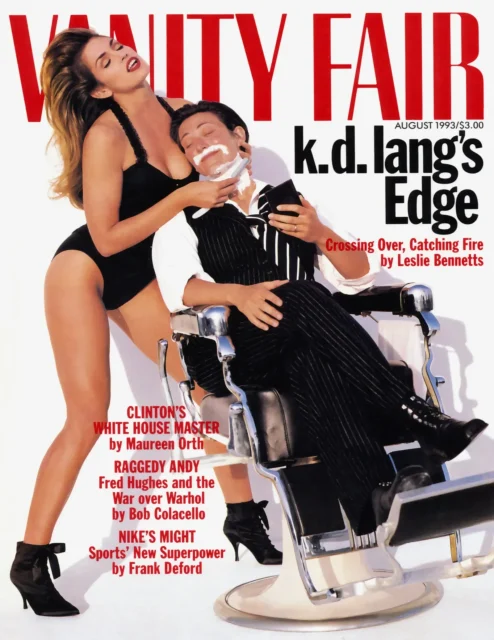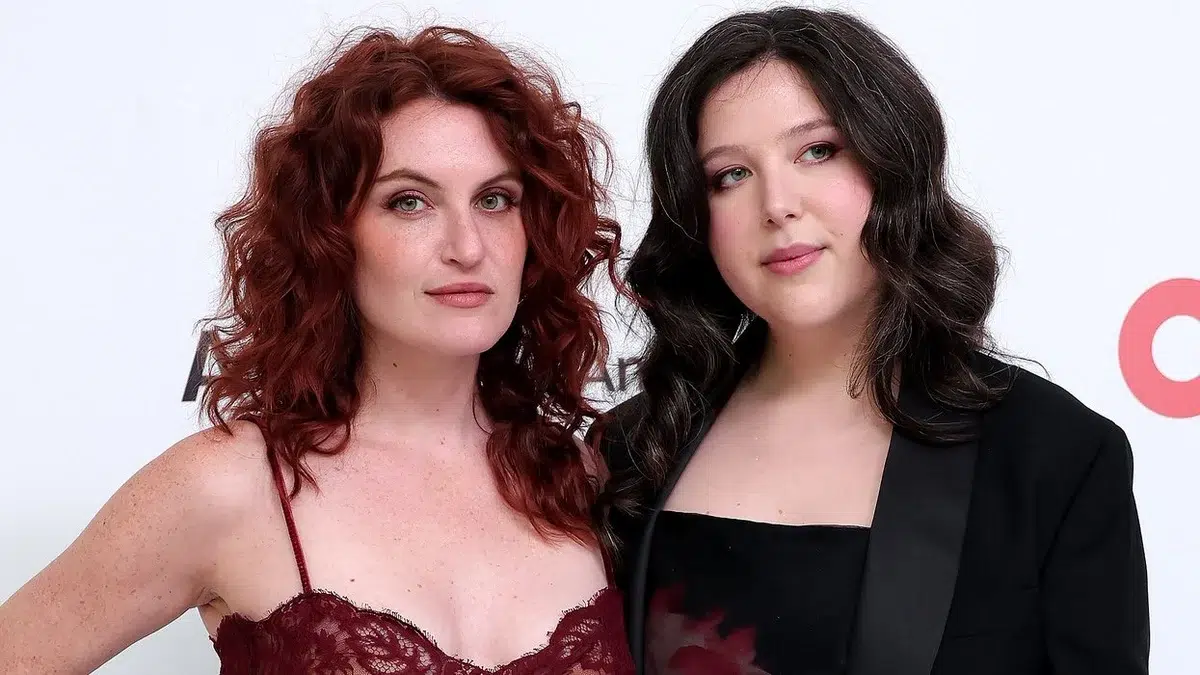Lucy Dacus and Katie Gavin, lead singer of MUNA, have brought us a powerful tribute to sapphic history, recreating one of the most iconic magazine covers from the ’90s. The duo graces the April 2025 cover of Alternative Press, bringing a modern twist to the 1993 Vanity Fair cover featuring k.d. lang and Cindy Crawford.
For the recreation, Dacus, known for her introspective lyrics and powerful vocals, adopts a bold menswear look, lounging in a barber’s chair, while Gavin, exuding a mix of sass and confidence, stands poised in a swimsuit and boots, razor in hand, ready to give Dacus a shave. The image evokes a powerful sense of gender subversion, paying tribute to the original cover that challenged societal expectations and celebrated queer representation in pop culture.
This nod to the past is not just a stylish visual callback; it serves as a poignant reminder of the strides that have been made in queer visibility while also emphasizing the ongoing relevance of the conversation about gender, attraction, and identity.
View this post on Instagram
A Moment in Queer History
The original Vanity Fair cover, shot 32 years ago, was groundbreaking for its time. Featuring lang and Crawford, the image was a bold statement that subverted traditional gender roles. It came at a time when LGBTQ+ visibility was limited, and being openly queer was still a controversial and often taboo subject, especially in the mainstream media. The cover, with its mix of butch-femme imagery, helped challenge long-standing stereotypes and paved the way for more inclusive representations of sexuality in the years to come.
At that point, lesbian representation was often minimized or outright ignored, and the idea of queer public figures was still novel. The fact that Vanity Fair embraced such an image was revolutionary, offering a rare space where butch-femme dynamics could be seen without shame. The cover’s impact was felt in the wider cultural landscape, where even subtle representations of queerness were met with resistance. This was just a few years before Laura Dern’s career took a hit for guest-starring in an episode of Ellen in which her character came out as a lesbian—a moment that temporarily derailed her career.

Vanity Fair cover with k.d. lang and Cindy Crawford.
Fast forward three decades, and the reimagining by Dacus and Gavin brings back a sense of nostalgia, while also highlighting how much has changed—and how much still needs to change. In a political climate increasingly hostile to LGBTQ+ rights, the image provides a stark contrast to the current wave of anti-LGBTQ+ rhetoric and legislation sweeping across parts of the world, particularly in the United States.
A Powerful Statement for the Present Day
Both Dacus and Gavin have long been vocal about their queerness, using their platforms to challenge societal norms and create space for LGBTQ+ individuals in the music industry. Dacus, known for her introspective indie rock, and Gavin, the frontwoman of the indie-pop group MUNA, have both carved out significant niches for themselves, unapologetically expressing their queerness through their music and personal lives.
For them to channel lang and Crawford’s iconic cover feels like more than just a simple homage—it’s a continuation of an ongoing conversation about gender and sexual identity that has persisted over decades. The recreation of this cover is an intentional, thought-provoking moment that shows how far queer representation has come, while also underscoring the challenges that continue to persist, especially as anti-LGBTQ+ sentiment rises.
The juxtaposition of the cover’s release in 2025, during a time when LGBTQ+ issues are under attack, only adds layers to its meaning. The photo offers a visual reminder that queer joy, history, and art will continue to thrive, regardless of those who seek to diminish or erase them. It’s a defiant statement that queer culture and visibility are here to stay, pushing back against the current political tides and ensuring that the voices of LGBTQ+ individuals will remain strong and proud.
Timeless Style, Timeless Message
On a purely aesthetic level, Dacus and Gavin’s recreation of the Vanity Fair cover highlights something that remains true despite societal shifts: a well-tailored suit, a bold lip, and a bit of playful subtext will never go out of style. The striking nature of the image is timeless, offering a visual punch that subverts expectations and challenges norms, while embracing a joyful expression of queerness.
The duo’s decision to take on this cover in 2025 also speaks to the broader culture of reclaiming and redefining symbols of queerness. As more LGBTQ+ artists take up space in the mainstream, these kinds of images become increasingly important in shaping a culture of acceptance and pride.
A Powerful Legacy of Representation
Dacus and Gavin’s tribute to lang and Crawford serves not only as a nod to an iconic moment in queer history but also as a call to action—reminding us that the fight for visibility and acceptance is ongoing. The image serves as a celebration of both how far the queer community has come and how much work remains to be done.
The resurgence of this image at a time when queer rights are increasingly under attack is a powerful form of resistance. It’s a statement of defiance, a reaffirmation of the importance of queer representation, and a celebration of the diversity of identities within the LGBTQ+ community.
In the end, this recreation is more than a stylish homage; it’s a bold declaration that the conversation about gender, sexuality, and identity is far from over. Just as lang and Crawford’s original cover changed the landscape of queer representation in 1993, Dacus and Gavin’s 2025 recreation continues to push boundaries, making a statement for the present while honoring the past.
The Alternative Press cover featuring Dacus and Gavin is a visual reminder that queer history is rich, vibrant, and enduring—and it’s not going anywhere, no matter the challenges it faces.







